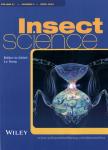A SURVEY OF SIZES AND WEIGHTS OF BEMISIA TABACI(HOMOPTERA: ALEYRODIDAE)B BIOTYPE LIFE STAGES FROM FIELD GROWN COTTON AND CANTALOUPES
棉花和香瓜的甘薯粉虱Bemisia tabaci (同翅目 ,粉虱科 )B生态型虫体大小和重量的田间调查(英文)作者机构:USDAARSWestern Cotton Research Laboratory4135E.Broadway RoadPhoenixAZ85040 USA USDAARSBiosciences Research LaboratoryFargoND58105 USA Cukurova UniversityAgricultural FacultyDepartnrent of Plant Protection01330AdanaTurkey Electron Microscopy CenterNorth Dakota State UniversityND58105 USA
出 版 物:《Entomologia Sinica》 (中国昆虫科学(英文版))
年 卷 期:2003年第10卷第2期
页 面:121-130页
核心收录:
学科分类:0710[理学-生物学] 0830[工学-环境科学与工程(可授工学、理学、农学学位)] 07[理学] 09[农学] 0904[农学-植物保护] 0901[农学-作物学] 090402[农学-农业昆虫与害虫防治] 0713[理学-生态学]
主 题:Bemisia tabaci B biotype Bemisia argentifolii body size body weight body volume parasitized exuviae
摘 要:Size and weight measurements were made for all the life stages of Bemisia tabaci (Gennadius) B biotype from field grown cotton ( Gossypium hirsutum L. ) and cantaloupe ( Cucumis melo L., var. cantalupensis )in Phoenix, AZ and Fargo, ND, USA in 2000 and 2001. Nymphal volumes were derived from the *** average nymphal volume increase for settled 1 st to the late 4th instar was exponential. The greatest increase in body volume occurred during development from the 3rd to early 4th instar. Nymphs on cotton leaves were wider,but not longer compared with those on cantaloupe. Ventral and dorsal depth ratios of nymphal bodies from 1st tolate 4th instars from cantaloupe leaves were significantly greater compared with those from cotton leaves. During nymphal development from 1st to 4th instar, the average (from the two host species) ventral body half volume in-creased by nearly 51 times compared with an increase of 28 times for the dorsal body half volume. Adult female and male average lengths, from heads to wing tips, were 1 126 μm and 953 μm, respectively. Average adult fe-male and male weights were 39 and 17 μg, respectively. Average widths, lengths, and weights of eggs from cottonand cantaloupe were, 99 μm, 197 μm, and 0.8 μg, respectively. Average widths, lengths, and weights for exu-viae of non-parasitized nymphs from both cotton and cantaloupe were 492 μm, 673 μm, and 1.20 μg, respective-ly; and widths, lengths, and weights of parasitized nymph exuviae were 452 μm, 665 μm, and 3.62 μg, respec-tively. Both exuviae from non-parasitized and parasitized nymphs from cotton leaves were wider, longer, and heavier than those from cantaloupe leaves.



